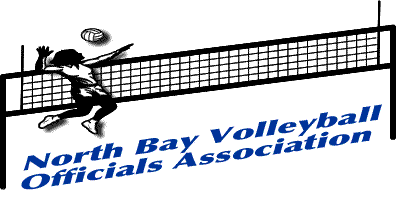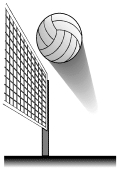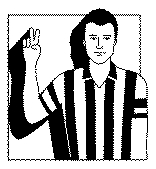
| Home |
| About |
| Schedules |
| Officials Access |
| Coaches Access |
| Education |
| Forms |
| Leagues & Schools |
| Links |
 |
Philosophy on the Legality of Sets
| Introduction | Making calls during rallies are the referee’s responsibility. The following are things to look for during play. | ||
| Using Your Vision | During play pick up the player who’s going to hit the ball and watch as contact is made. Don’t track the ball all the way, except for a ball that may go near the ceiling. | ||
Sets
|
A set is an overhead two (or one)-hand finger action directing the ball to an attacker or to the opponents. When judging the legality of sets or passes two factors come into play:
+Set your standards early so the players and coahces know what the parameters are for the match. It is better to call the match tight early then loosen up (a little) then to try to tighten up after letting several sloppy calls go. Athletes and coaches will adjust to what is being called. |
||
| Time of Contact | Time of contact is when ball contacts the setter’s hands. By rule the ball should hit both hands at the same time and “pop” out immediately. Good setters have proper hand placement prior to time of contact. The hands are set and locked into position prior to contact. The ball contacts the hands and leaves the hands like a ball bouncing off the ground with very little spin. The following are clues that the time of contact was illegal:
|
||
| Execution |
+The above are only clues that the execution was bad and may be illegal. Some setters are very good with their hands. They will set and lock their hands into proper position in order to set the ball other than directly in front of or behind them. The key is to see the position of the setter and the position of the hands prior to the time of contact. |
||
| Coaches Want It Called | Even coaches want bad execution called on their players. Why? Because that is not what they teach when it comes to teaching setting. You will not get into trouble from that coach for calling doubles on sets for bad execution. |
||
| Judgment Levels | Not all “time of contacts” are illegal nor are all bad “executions”. We can be flexible dependent on the level of play. At lower levels of play we can only be flexible if one of the above mentioned criteria is good.
At higher levels of play the level of setting should be called a little tighter for each criteria. At all levels the following must be called:
|
||
Multiple Contact
|
Multiple contact can occur on any first contact. However the following cannot occur:
+First contact that hits the fingers and goes off is multiple contact, but the player was not using “finger action” to the play the ball – the ball “played her.” |
||
| Seeing It | After the ball has been legally hit look ahead and pick up the next player who is going to hit the ball. This player will usually place their hands in one of the following positions in order to hit the ball:
By watching the player that is about to hit the ball you can anticipate the hitting action. Put your vision on the player’s hand as the ball comes into their hands. Use your peripheral vision to track the ball while you are looking for the next hitter, except for a ball that may hit the ceiling. |
||
| Consistency | The final key to all of this is consistency. The key to consistency is remembering what you’ve been calling or not calling. |
DataBase Management Services





